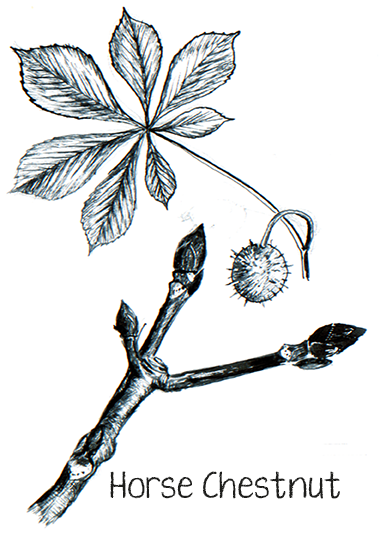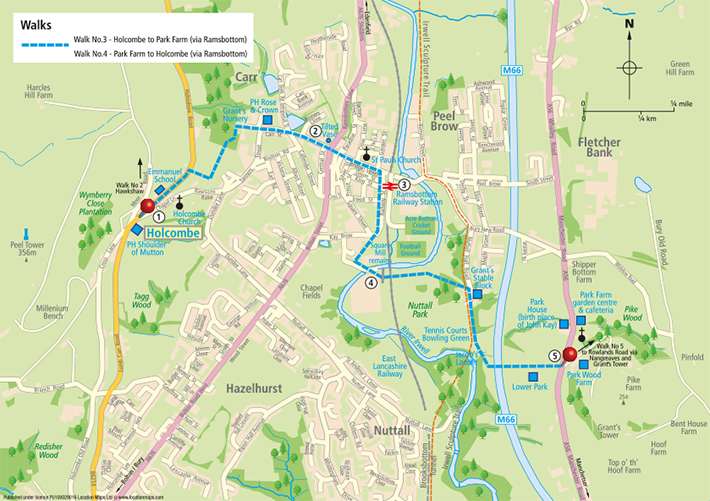 |
Click to download walk |
Holcombe village is unique in the area, an excellent example of a pre-industrial settlement almost untouched by recent developments and well worthy of its conservation area status. The village is believed to have been settled since the early medieval period and probably had a praying station there as early as 1225. Many houses date from the 17th and 18th centuries and one of the oldest being Hey House (1616). Holcombe’s sporting traditions are legend and has some of the oldest hunts in England. The Holcombe Old English Game Fowl show held until recently at The Shoulder of Mutton, every New Year’s Day, is reputably the oldest in the country and evidence of the village’s historic cockfighting traditions. The Holcombe Wakes held annually until 1880 were known far and wide for their drunkenness and debauchery.
|
 Starting with your back to the Shoulder of Mutton, turn right and head north along Helmshore Rd, past the village school on the left, to the first bend. Starting with your back to the Shoulder of Mutton, turn right and head north along Helmshore Rd, past the village school on the left, to the first bend.
|
| The village school opened in 1864 was built by stone quarried locally and free labour. The school bell on the roof is inscribed Richard Fletcher, Warden,1698 and came from the old Holcombe Tudor Chapel of Ease. Look carefully for the shrapnel marks on the stone work on the right hand corner as a result of the only bombing raid on Holcombe when in Sept 1916 a Zeppelin appeared in the night sky and dropped 5 bombs. Another badly damaged the Post Office directly across the road from the Shoulder car park. The only casualty in the village was a thrush, which was stuffed and mounted in a glass case, with its feet in the air just as it was found and given an official First World War memorial number and has been kept at the school ever since. |
At the public footpath sign turn right, taking care down the stone steps, follow the path as it meanders down the hillside through the trees. As the path levels out, go into the mature conifer woodland (Grant’s Nursery) and head downhill to the wooden ‘kissing gate’ in the far right hand corner of the wood. (By the last house at the left hand end of the terrace). Go down the narrow path around ‘Manor House’ to emerge onto the steep and cobbled Manor Street.
  Go straight on past the ‘Rose and Crown’, the oldest pub in Ramsbottom (1797), and down Carr St into Ramsbottom town centre. Go straight on past the ‘Rose and Crown’, the oldest pub in Ramsbottom (1797), and down Carr St into Ramsbottom town centre.
Devils Hole lodge, on the left, is a popular spot with anglers and where the ducks that live on the lodge have their own bank account into which all contributions for their welfare are paid.
Ramsbottom (a name straight from the music hall) is largely a 19th century creation and a good example of a Pennine textile town. Since the decline of its textile roots it has successfully transformed itself via being granted conservation status in 1977 and the arrival of the East Lancs Railway in 1987 into a popular tourist destination. Bolton and Bridge streets have retained many of their original feature as does the Market Square at the heart of the town which hosts a farmers’ market monthly and is surrounded by good restaurants and an interesting selection of shops. The town was voted by the Daily Telegraph in December 2013 to be the runner up in a national competition to find most attractive high street in the land. |
 Having explored the town, and the many delights that Ramsbottom has to offer, go down Bridge St past St Paul’s, the Parish Church (built on land donated by local mill owning family the Ashtons in 1850) and, just before the level crossing, turn right into Railway St passing Ramsbottom Railway Station on the left. Having explored the town, and the many delights that Ramsbottom has to offer, go down Bridge St past St Paul’s, the Parish Church (built on land donated by local mill owning family the Ashtons in 1850) and, just before the level crossing, turn right into Railway St passing Ramsbottom Railway Station on the left.
|
| After the formal closure of the line in 1982 it was reopened in 1987 as the East Lancashire Railway, run by volunteers. It’s 12 miles long, and runs between Rawtenstall and Heywood. every weekend, all year round. The signal box was built in 1939 and is one of the last manually controlled main road crossing in the country. ELR have ambitious plans to extend the line and number of stations in the future and successfully run and organise different events varying from War Weekends to Santa Specials throughout the year. |
| At the far end of Railway St do not bear right (by the Aldi car park) but continue straight ahead alongside the iron railings and around to the left, signposted Nuttall Park, crossing the bridge over the River Irwell. |
| Note on the opposite river bank the original stone foundations of the famous Square Mill, in its day the largest dyeing and bleaching mill in Europe if not the world. Built by the Grants in 1821 and because of industrial unrest prevailing at the time, it was moated like some medieval castle, with only a drawbridge to get in or out of the mill. In the river below the foundations there are plenty of brown and rainbow trout. |
 Follow the path by the river across the front of Holme Mill, the home of Cormar Carpets and through the foot tunnel beneath the railway line into Nuttal Park. Follow the path by the river across the front of Holme Mill, the home of Cormar Carpets and through the foot tunnel beneath the railway line into Nuttal Park.
 Beyond the tunnel there’s a choice to either continue:- Beyond the tunnel there’s a choice to either continue:-
a. Straight ahead and follow the path along the river bank before veering to the right and joining Nuttall Hall Rd, (a section of the Irwell Sculpture trail) Or,
b. Go diagonally across the park to the far side via the bowling greens, tennis courts, children’s playground, and car park to also join Nuttall Hall Rd.
The Irwell Sculpture Trail is the longest public art scheme in England that runs along a well-established footpath for 30 miles between Salford Quays and Bacup, containing 28 art pieces the work of both national and international artists.
The park, Nuttall Hall and the cost of installing all the existing features and facilities were donated to the town in 1928 by a local mill owner and philanthropist Lt Colonel Austin Porrit for the health and welfare of its residents. The park was purchased originally in1812 and developed by the John Grant who built the hall as a family home in 1817 together with stable blocks and outbuildings which still survive to this day. The hall was demolished by the council in 1952. |
|
Turn right down Nuttall Hall Rd and just before the pedestrian bridge over the river, turn left over a small stone bridge and up
a long flight of steps known locally as ‘Jacob’s Ladder’. |
| Now largely forgotten and unknown but once a renowned beauty spot where people, in days before television and the internet, came from far and wide to see the gorge, clearly seen on your left as you go up the steps, and its waterfall which is most impressive for days after heavy rain. The steep climb, named ‘Jacob’s Ladder’ (a stairway to heaven) as for many years the congregation that worshipped at Park Chapel above and many of the people who worked in the early mills in Nuttall village. |
Emerging at the top of Jacob’s Ladder follow the path up and over the pedestrian bridge across the M66.
It’s perhaps worth pausing for a moment as you cross the bridge to appreciate the calm and tranquillity of the walk you are enjoying compared to the unrelenting noise, speed, pace and endless urgency of the traffic passing beneath your feet
 From the bridge cross the meadow heading for ’Lower Park’ house and a wooden stile and follow its partly cobbled access track uphill to Manchester Rd. From the bridge cross the meadow heading for ’Lower Park’ house and a wooden stile and follow its partly cobbled access track uphill to Manchester Rd. |
| Across the field to the left, you will see Park Farm, where John Kay the inventor of the ‘flying shuttle’ which revolutionised the textile industry in the 18th century was born in 1704. His father was a yeoman farmer who then owned the Park Estate. He invented the’ flying shuttle’ aged 26, which halved the labour required to operate a loom. Due to a combination of the resistance of the weavers to use it and the abuse of his patent rights on the shuttle by other manufacturers and despite inventing many other improvements, he sadly died in Paris in 1779 penniless and a forgotten man. |
| To continue the Walk No 5 to Rowlands Rd via Grants Tower and Nangreaves, cross Manchester Rd onto the lane going uphill directly opposite. |
 |
| BACK TO TOP |
| |
| |
| |
|
|


 Follow the path by the river across the front of Holme Mill, the home of Cormar Carpets and through the foot tunnel beneath the railway line into Nuttal Park.
Follow the path by the river across the front of Holme Mill, the home of Cormar Carpets and through the foot tunnel beneath the railway line into Nuttal Park.